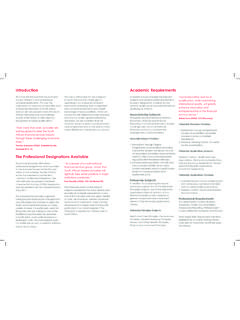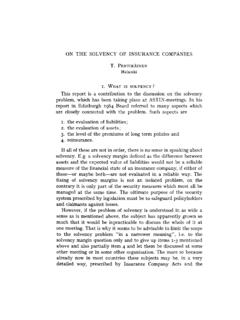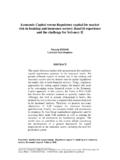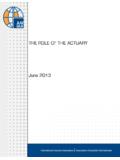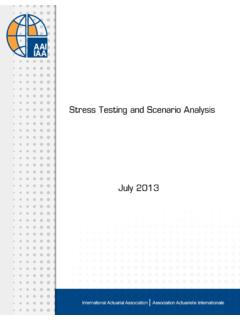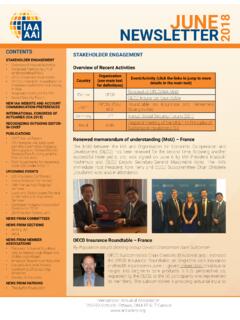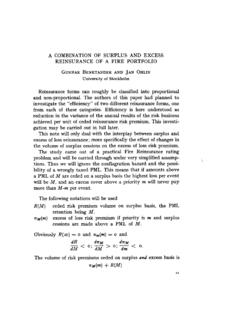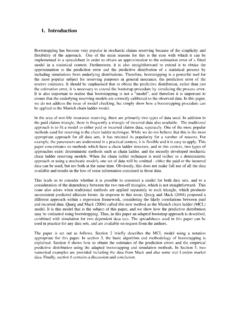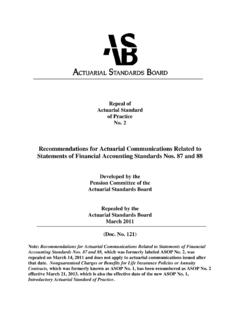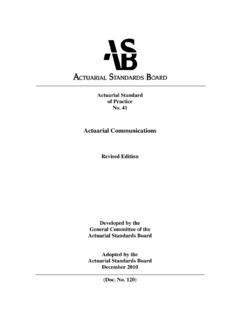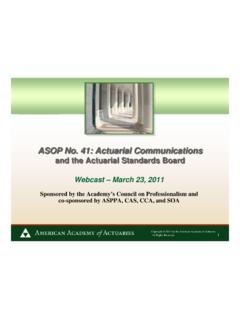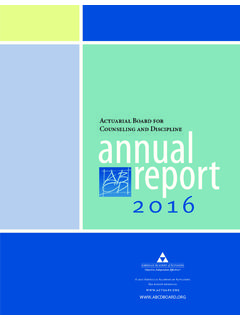Transcription of Actuarial Standards Committee - MENU
1 International Actuarial Association ISAP STYLE GUIDE AND TEMPLATE Revised on 26 March 2014 Actuarial Standards Committee ISAP Style Guide and Template (revised on 26 March 2014) Actuarial Standards Committee i Table of Contents Introduction .. 1 I. Format and Expected Content .. 2 A Content of an ISAP .. 2 B. Format of an ISAP .. 2 C. Defined Terms .. 2 D. Layout and Typography .. 2 E. Wording .. 5 II. Template .. 7 A. Cover Page .. 7 B. Table of Contents .. 10 C. Body of ISAP .. 10 III. Writing Guide .. 18 ISAP Style Guide and Template (revised on 26 March 2014) Actuarial Standards Committee 1 Introduction Typography used in this Style Guide The following fonts and colors have special meaning in this document: 1. Blue text with dotted underline indicates a defined term in an ISAP.
2 (In the ISAP it is a hyperlink to the definition.) 2. Green text indicates an example; 3. Black italics are instructions that should be in the ISAP but are intended to be removed from any adopted version of the ISAP. 4. Purple italics are instructions to the drafter of an ISAP and should not appear in the ISAP. International Standards of Actuarial Practice (ISAPs) are designed to be documents that: Enable actuaries in widely varied jurisdictions to work to similar Standards ; Can be easily understood, as far as is practical, by actuaries in many different countries; and Set out, clearly and succinctly, guidelines for actuaries to follow in situations that may be both unusual and problematic. Given that goal, ISAPs are necessarily detailed and their creation can create difficulties for those unused to such writing.
3 This style guide aims to support any actuary tasked with drafting an ISAP. It includes: A guide to the format and expected content of an ISAP; The template for ISAPs; and A writing guide, containing more specific information on issues that might occasionally arise. This guide cannot be comprehensive, but might answer an actuary s questions concerning conventional approaches to typography, punctuation, and more. The ASC recommends the Oxford online dictionary ( ) as a useful reference. ISAP Style Guide and Template (revised on 26 March 2014) Actuarial Standards Committee 2 I. Format and Expected Content A. Content of an ISAP A1. An ISAP should cover only one topic. For example, an ISAP relating to International Financial Reporting Standards (IFRS) should address only matters directly relevant to an actuary doing work under IFRS.
4 In particular, guidance on general topics, such as data quality or communications, should be strictly limited to matters directly relevant to IFRS, rather than matters that would be covered under a general data quality or communications standard such as ISAP 1. A2. An ISAP should articulate principles rather than rules. The principles articulated should be globally applicable. B. Format of an ISAP B1. Preliminary sections: Cover page; Table of contents; Preface (to be discarded when the ISAP is adopted by a standard-setting body); and Introduction (to be retained when the ISAP is adopted by a standard-setting body) (optional). B2. The standard itself: Section 1 General. This section defines when, to whom, and to what work the standard applies, and contains general items of guidance.
5 Section 2 Appropriate Practices. Section 3 Communication. Each section begins on a new page. B3. Appendices as needed (explanatory or other useful material; these appendices are not part of the standard, and are not binding on the practitioner). C. Defined Terms C1. Terms are not defined locally in each ISAP, but defined in the G lossary, a separate global document which applies to all ISAPs. The Glossary indicates which ISAPs use each defined term. C2. Every occurrence of a defined term should be a hyperlink to the definition. Hyperlinks should be obvious to a reader of a black-and-white paper copy, by identifying them with a dotted blue underline (R=0 G=0 B=255) which will show equally well in black-and-white print ( , sample). D. Layout and Typography Layout D1.
6 A4 paper (21cm by cm or by ) with margins of 2cm ( ) at the top, left, and right and 3cm ( ) at the bottom. ISAP Style Guide and Template (revised on 26 March 2014) Actuarial Standards Committee 3 D2. Headers Each page of the exposure draft should have the following header: Exposure Draft [nn] ISAP [number] [ Title of ISAP] [Month Year] Each page of the standard should have the following header: ISAP [number] [Title of ISAP] [Month Year] D3. Each page should be numbered in the centre of the footer. The page starting with Section 1. General is page 1. Text D4. Times New Roman 12 pt, left justified only ( , with a ragged right margin as used in this document). D5. Sentences should be separated by a single space. Rarely, sentences to be emphasized should be in bold.
7 D6. Space 6 pt before and after each paragraph, single spaced. Headings and Numbering D7. The style of headings should be as follows: Section [n]. Heading ( , bold, with title capitalization 1, and centred on the page). D8. Legal-style paragraph numbering will go three deep ( , ). Lists below that will be lower case letters (a., b., c., etc.), and below that romanette (i., ii., iii., etc.). D9. Paragraph titles ( , ) will be shown in bold type with title capitalization 1 set off from the paragraph by an en dash2, not a hyphen (but no line break). Numbering is in bold. For example: Purpose Paragraph starts here .. D10. Subparagraph titles ( , ), if present, will be underlined with title capitalization, set off from the subparagraph by a hyphen (but no line break).
8 Numbering is in roman. Subparagraphs are not required to have titles, but there should not be a mix of titled and untitled subparagraphs under one paragraph. For example: Definition - Paragraph starts here .. Text continues in a second paragraph here .. If the subsequent subparagraph is dealing with the same subject as the numbered subparagraph, then it should not be numbered and essentially forms part of the numbered subparagraph even though a new line was commenced. On the other hand, if that next subparagraph is really introducing a new subject, it requires a new number. 1 All words other than articles, conjunctions, and prepositions should start with a capital letter. 2 See Dashes, page 21. ISAP Style Guide and Template (revised on 26 March 2014) Actuarial Standards Committee 4 Lists D11.
9 Letter lists are preceded by a colon, would usually, but not always, be sentences, and are terminated with semi-colons. Each line should begin with a capital letter. For example: a. The actuary might consider the expectations of the principal; or b. If the actuary believes circumstances are such that including certain content is not necessary or appropriate, the actuary should be prepared to describe them. D12. Romanette lists are preceded by a colon, would usually, but not always, be words or phrases, and are terminated with semi-colons. Each line should begin with a capital letter. For example: i. ISAP 17; ii. The introduction of ISAP 3; and iii. Development of ISAP 12. D13. Lists, other than those with lines consisting of full sentences that can stand alone, normally have one conjunction before the last entry.
10 The conjunction is and for a list where all items apply and for sets of items ( , following such as ). The conjunction is or where one item should be selected from a complete list. D14. Bulleted lists may appear under paragraphs that are not subparagraphs. They should not be used if elements of the list might need to be cross-referenced. They are preceded by a colon. For instance: Purpose This ISAP provides guidance to actuaries when performing Actuarial services to give intended users confidence in particular that: Actuarial services are carried out professionally and with due care; The results are relevant to their needs, are presented clearly and understandably, and are complete; and The assumptions and methodology (including, but not limited to, models and modelling techniques) used are disclosed appropriately.
